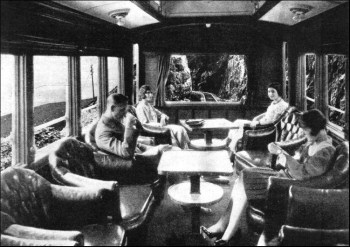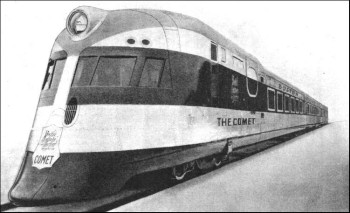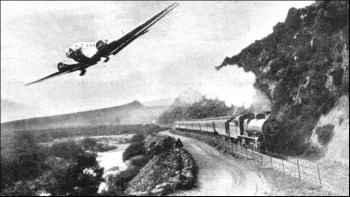
Rail Transport in the 1930s
an article for Trail of Cthulhu by Simon Carryer
The 1930’s was a period of great innovation in rail technology. The steam locomotive, having dominated overland transport for almost a century, was for the first time challenged by alternative modes, most significantly in the form of the automobile, and the diesel locomotive. Technology developed for the war was rapidly turned to civilian purposes, and rail transport was no exception. The replacement of old manual semaphore signals with automatic electric signals significantly reduced the manpower required for the operation of a railway, while increasing speeds and efficiency. A new understanding of streamlining, adapted from aircraft technology, lead to groundbreaking increases in top speeds, while the ubiquity of rail travel saw it become less a luxury, and more an everyday occurrence. Of course, these developments were not implemented at once all over the world. Even in Britain and North America, where most of the innovation was happening, the long service life of steam trains meant that new technology was slow to be implemented, Indeed, it was in developing countries where the new technologies were often most successfully employed. Advances in engineering made possible rail routes that were previously unthinkable, and a rush to exploit the resources of these nations made such routes extremely lucrative.
The rail traveller of the nineteen thirties was as likely to be a wealthy first-class passenger on a sight-seeing trip as a worker on a daily commute. Standards of luxury varied immensely, from dining cars as plush as any hotel suite, to trucks little more furnished than a cattle car. For most routes, the option of first-class travel was available. Long distance first-class travellers could expect a full meal service, and a sleeper cabin, to be shared with at most one other passenger.
The character of rail transport, both in the comfort for the traveller, and the speed and availability of passage, varied enormously between countries. Below is a broad outline of some national trends.
North America

Hit hard by the Depression, challenged by burgeoning numbers of automobiles, and left in poor shape after government management during the war, North American rail networks were for the first time struggling to make ends meet. The answer was modernization. One of the first diesel-powered passenger trains, the Zephyr, cut the record time for the 1,015 mile journey between Denver and Chicago almost in half on its maiden trip in 1934. With its aerodynamic, stainless-steel look, the Zephyr was an influence on the design of architecture, consumer goods, and other vehicles. The modernization of North America’s rail networks led to a reinvigoration of the industry, and soon the States’ railways were an economic success once again.
Africa
The exploitation of the vast natural resources of the African continent was enormously expedited by the development of rail networks throughout the 1930’s. Though extracting Africa’s natural wealth was a task begun decades earlier, by the 1930’s railways were still being built, working towards the dream of an Africa-wide rail network. During the decade, the journey from Cairo to the Cape was never possible to achieve exclusively by rail. Though there were extensive rail lines in both the north and south of the continent, these tracks were not connected during the 30s.
In the southern part of the continent, the major western trading port of Lobito was connected across the spine of Africa, through Portugese West Africa, through the copper fields of the Belgian Congo, on to Bulawayo. From there the track diverged, travelling east to the seaport of Beira, or south to Cape Town.
While for the most part African rail was dedicated to the transport of freight, and spared little for the comfort of passengers, the express service between Cape Town and Johannesburg was considered one of the most luxurious in the British Empire. It featured a magnificent dining car, with seating for 46, and an observation coach at the rear of the train. The passenger was able to take a shower, and have shoes and clothes cleaned, all aboard the train.
Trains were often used for the transport of diamonds, and extreme precautions were taken to safeguard the cargo. Safes were built raised from the floor of the van, with a clear view all around the carriage.
In North Africa, the rail network was less sophisticated, and frequent changes between various gauges, or to overcome natural obstacles, were common. In several instances, the distance between each length of track was significant, and had to be completed by boat, by truck, or even by foot. Journeys by rail in North Africa, while sometimes perilous, and certainly falling short of the standard of luxury expected by American or British travellers, would afford the traveller unique views of wildlife, Roman ruins and ancient temples.
Europe
Of all the European railways, and indeed of all the railways in the world, it was Europe’s Orient Express that was the most famous of the decade. Running from Calais to Bucharest, and passing through France, Germany, Austria, Czechoslovakia, Hungary and Romania, the Orient Express was popular both with tourists and with everyday travellers. Prior to 1935, the Express carried only first-class passengers, as was normal for many of Europe’s most prestigious lines. Subsequently, however, several standard-fare coaches were included on many stretches of the route, catering to the more mundane local traffic. By the end of the decade, as with most rail routes, first class was considered a Òfancy extra" to normal, second-class travel.

For first-class passengers, the Orient Express was a magnificent journey through foreign lands, conducted in the height of luxury. Conductors would attend to the needs of the passengers diligently, not only making up beds and serving food, but also preparing the documents of travellers so they might cross the borders of the many countries the Express visited in their sleep, without being disturbed.
Also of note in Europe was the Trans-Siberian Express, even in the Thirties famed among travellers as a unique way to see Russia and the near East. Russian trains were in many ways different from those of Europe and Britain. Most obviously, their gauge was much wider, allowing the coaches to be built very wide, and very tall. To protect from the Russian cold, most trains, and event the gaps between cars were completely enclosed.
While popular with tourists, the Trans-Siberian was also a vital part of domestic Russian travel, and the foreign tourist was likely to be accompanied by many diverse travellers from all across Russia and Europe. In recently Communist Russia, "class" was a forbidden word, and hence "first class" and "second-class" tickets were unavailable. Instead, cars were designated as "hard" or "soft", with accompanying differences in price and comfort. "Hard" cars were lined with bunk-beds, and lit exclusively by candles, while passengers in "soft" cars could enjoy more modern comforts.
China
The development of rail networks was met by fierce opposition from the Chinese public, as well as from Chinese government. Construction encountered numerous difficulties, from flooding and mudslides, to the many ancient gravesites that had to be avoided. Chinese railways often took circuitous routes to avoid such locations, and in mountainous areas, which comprised a large portion of the total network, tunnelling was preferred to blasting areas of hillside, for the reason that it was less likely to disturb such ancient burials. In many cases, especially following deaths of workers, irate locals would tear up tracks, in an attempt to forestall construction. European interests in China were relentless, however, and even within China there were many rail supporters. A great many of China’s railways were developed by foreign powers, for the purposes of furthering their industrial endeavours in China. As such, passenger services within China were of a completely different standard than elsewhere in the world. Chinese workers often travelled in unfurnished cars with open tops, exposed to the elements. Tourists were not unheard of, however, and several passenger cars of a type more familiar to foreign travellers operated between major centres.
South America
South America, with its many mountains, rivers, and swamps, was for a long time considered an impossible location for rail engineering. Technological advances in the 30’s however made possible feats of engineering that made large parts of the continent suddenly accessible by rail. It was not possible to travel the length of the country by rail, and indeed there was no rail route between North and South America in the thirties. The longest stretch of unbroken track ran the length of the coast of Chile.
The transit of the Andes, vital to South American trade, was completed by rail in 1908, but the route was not commercially viable until the development of more efficient steam locomotives enabled significant loads to be carried up the steep grades. The route, between Buenos Ares, and Valparaiso, Chile, climbs to over 10,000 feet above sea level.
Adventure Seeds

Long Buried: The incursion of railways into mountainous territory necessitated tunnel building on a previously unheard of scale. In South America, India, China, and many parts of Europe, the construction of alpine railways required tunnelling deep into the rock. Who knows what dark temples, long hidden from the sight of Man lie with these mountains, or what ancient horrors, working in secret, might be exposed by such diggings? What of the modern-day scions of such ancient cults? What would they do to preserve these long-forgotten secrets? Engineering crews would work isolated from settlements by many miles, often the very railway they were constructing was their only link to civilisation. A construction company might not look too carefully into the disappearance of a crew of native workers, if it could mean the delay of construction.
Strange Bedfellows: On long rail journeys passengers would often find themselves spending large amounts of time with relative strangers. In more exotic locales, this could mean rubbing shoulders with the strangest of people. In Russia, it was common for complete strangers, even of the opposite sex, to share a room. With journeys taking days, and often weeks, all manner of activity could arise. Passing between many different countries meant that trains, and the people on them, were very difficult to police. If some awful crime were committed aboard a train, especially if the crime had aspects of the supernatural, it might be left to the passengers of the train to discover the culprit, if local police forces proved too fearful or corrupt. Suspicion would quickly fall upon those passengers whose native customs or oddities of dress distinguished them from their fellows. However, even the most normal appearance might hide dark secrets.
Stranded: Railways would often pass through miles of the most inhospitable territory, often going for days without seeing another road or track. If some mechanical fault were to cause a train to stop, it might be days before the train was missed, and longer still before help could be mustered. In this intervening time, the passengers would be left to their own devices. For a small group of passengers on a train dedicated mainly to freight, such as was common in Africa and South America, such a time could become a nightmare of hunger and apprehension. What if there was some hint that the malfunction was caused by human hand? For what dark purpose could someone want to strand a group of people deep in the wilderness?
Bibliography
- Mike's Rail History A Mission to Civilize: Republican Idea of Empire in France and West Africa Conklin, A.
- Shattered Rails, Ruined Credit: Financial Fragility and Railroad Operations in the Great Depression Schiffman, D. Cambridge University Press
- rrhistory.com
Related Links
- Air Transport in the 1930s - a previous article.
- Discuss this article.
- Trail of Cthulhu webpage
- Trail of Cthulhu Pelgrane blog entries
- Writer Simon Calyer's PBP forum
